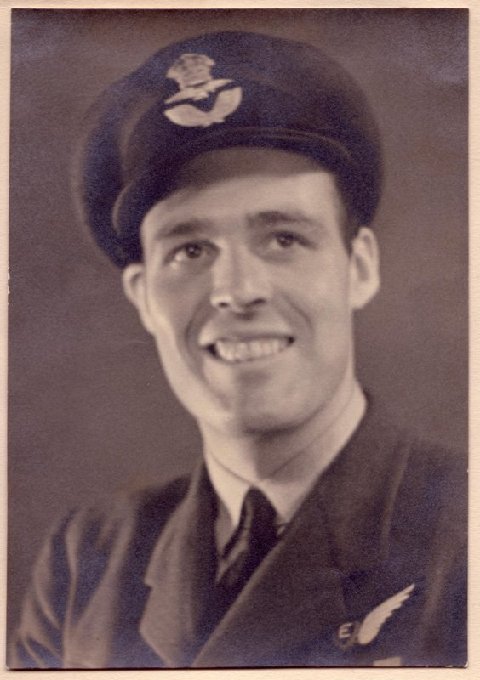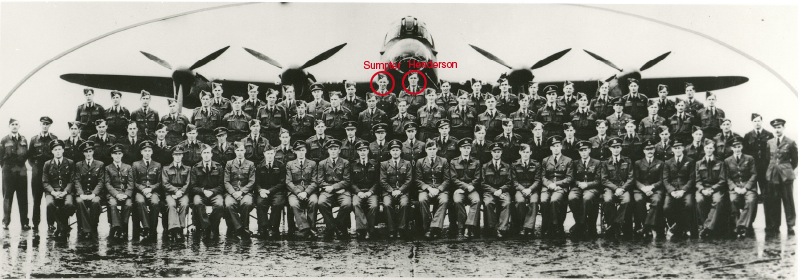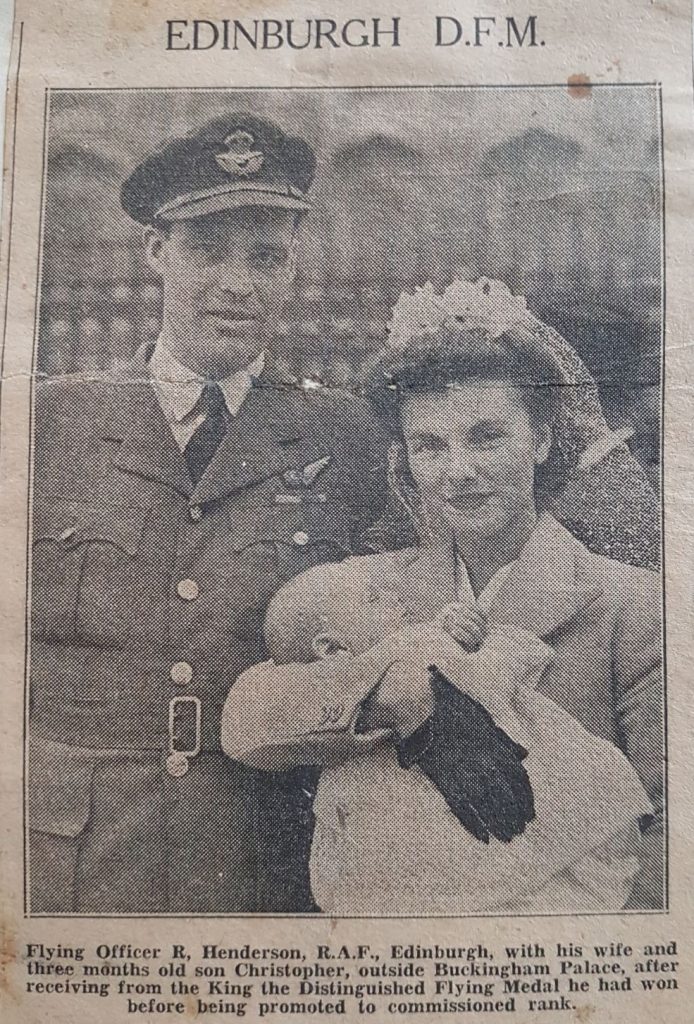This article appears in issue 50 of Ayrshire Magazine (Aug 23) and is reprinted here with the permission of Ayrshire Magazine (Scotland) Limited. Thanks also to Bob Henderson’s daughter in law, Debby, who made contact with the association and requested that Bob’s photo be included on our remembrance page.

On the night of 16th/17h May 1943, a force of RAF Lancaster bombers attacked the Möhne, Eder and Sorpe Dams in a raid that has passed into legend due to the skill and bravery of the young men who took part in it.
Some online sources state that one of those men, Robert Jack Henderson, was from Ayr. As it turns out, though, Bob Henderson wasn’t from Ayr. Nor, for that matter, were any of the other 132 young men who flew on that raid. Bob was, however, one of 12 Dambusters who were born in Scotland.
Bob was born on 17th June 1920 in the village of Tarbrax. He lived there until the age of five, when the closure of the shale oil works at Tarbrax resulted in his family moving a few miles to West Calder, where Bob attended school. Opportunities for further education for working class children were limited in those days, so Bob left school at 14 to take up an apprenticeship at Addiewell shale oil works.
One of the foremen at the oil works noted that Bob was a bright lad and, as he had done with other apprentices who showed promise, encouraged Bob to attend night classes in order to improve his education.
Bob remained at Addiewell until September 1937, when he joined the Royal Air Force Volunteer Reserve. He trained as ground crew at RAF Cranwell and served in that capacity with 78 and 207 Squadrons from 1940 until 1942. He was not, however, destined to remain on the ground.
The introduction of four-engined heavy bombers in the RAF in 1941 brought with it the realisation that a pilot could not hope to fly the plane and monitor all the flight-critical systems on his own. The rate of expansion of Bomber Command (and, sadly, the rate of its losses) meant that pilots simply couldn’t be trained quickly enough to supply two for each heavy bomber, so it was decided to train aircrew as flight engineers instead.
The flight engineer was, in every sense, the pilot’s right-hand man. It was a vital and demanding role, one that was ideally suited to a bright, technically-minded young man like Bob. His application to train as a flight engineer was successful, and he completed his training course in October 1942, thereafter being posted to 57 Squadron at RAF Scampton.
Between October 1942 and March 1943, Bob flew on 16 operational missions as the flight engineer in a Lancaster piloted by Flight Lieutenant George Curry. But when Curry was grounded because of a recurring ear problem, Bob’s crew no longer had a pilot. However, a new squadron, 617, had just been formed at Scampton, and word reached Bob’s crewmate, bomb-aimer Len Sumpter, that one of the pilots on the new squadron was looking for a flight engineer and bomb-aimer for his crew. A meeting was arranged, at which Bob and Len looked over the pilot and he, Flight Lieutenant Dave Shannon, a 20 year old Australian whose ability as a pilot was highly regarded, looked over them. The upshot was that Bob and Len were transferred to 617 Squadron with effect from 4th April, 1943, becoming key members of Dave Shannon’s crew.

In the weeks that followed, Bob and his new crew took part in a series of testing exercises involving low-flying, starting out at 200 feet and gradually getting ever lower. That 617 was intended to attack a special target was made evident when the squadron’s aircraft, specially modified Lancaster bombers, began to arrive.
The men of 617 were not, however, told what their target was to be nor its location. Indeed, even the squadron’s commanding officer, Wing Commander Guy Gibson, was kept in the dark about the upcoming target for a time. Gibson did know, however, about the weapon that the squadron would use, a curious looking bomb that resembled an oil drum on its side. It was designed to be dropped over water at a prescribed height, having first been rotated backwards at 500 revolutions per minute. On striking the water, it would skip across the surface of it like a stone before striking its target, sinking and exploding at a pre-set depth. The weapon was usually referred to by its codename, ‘Upkeep’, but most people would come to know it as the ‘bouncing bomb’.
As April gave way to May, 617 Squadron concentrated on low flying missions over reservoirs. Their training was ramped up even further on the 11th and 12th of May when some crews test-dropped inert Upkeeps, Bob’s aircraft being one of those involved. The training culminated in what amounted to a full-scale simulation of what was to come, when almost the whole of 617 Squadron ‘attacked’ the Colchester and Uppingham reservoirs on the night of 14th May.
In spite of the very specific nature of their training, most members of the unit only learned of their targets at briefings held on the day of the raid. After the main briefing, attended by all 133 of the aircrew who would participate in the raid, codenamed Operation Chastise, the crews were sent for their pre-flight meal. For many of them, it would be their last.
The 19 Lancasters of 617 Squadron were split into three groups for the mission. Gibson would lead the First Wave of nine aircraft, which included Bob’s Lancaster, to the Möhne and Eder Dams, the Second Wave of five aircraft would head for the Sorpe Dam, and a third wave (the ‘Mobile Reserve’) would take off two hours later and head to whatever targets they were directed to attack.
Bob’s flight position was on the right-hand side of the cockpit, in an area that doubled as the passage leading to the pilot’s, front gunner’s, and bomb-aimer’s positions. Once the aforementioned were all in their flight positions, Bob unfolded his seat from the side of the fuselage, where it was stowed when not in use, then clipped the strip of canvas that acted as the backrest into position and readied himself to go through the pre-flight checklist.
As the aircraft taxied into position, Bob’s attention was focused on two banks of instruments, one on the right hand side of the aircraft’s main instrument panel and the other on a panel to his right, watching for signs of any issues with the engines and fuel systems, looking out for anything that might affect the thirty ton aircraft’s ability to claw its way into the sky.
Bob’s Lancaster took off from Scampton at 21.47 and headed south-east, crossing the Suffolk coast and heading out over the North Sea about 40 minutes after take-off. The flight across the sea lasted about 30 minutes, during which the Lancaster pilots balanced the need to fly low enough to avoid detection by German radar against the very real risk of striking the dark, unyielding water.
Bob had little time to take in the view that his position in the cockpit afforded him, concentrating instead on monitoring the engines, fuel and electrical systems, adjusting settings as required, maintaining a regular log, and standing ready to take over the Lancaster’s controls if Shannon was incapacitated.
The Dutch coast was heavily defended by anti-aircraft guns mounted on both land and on coastal vessels. Much care and attention had been devoted to choosing a route that would minimise he Lancasters’ exposure to enemy fire, and the nine aircraft of the First Wave all successfully made it past the coastal defences. However, they now faced the daunting prospect of flying desperately low, at 100 feet or less, over unlit terrain which was host to an abundance of obstacles capable of swatting an aircraft from the sky in an instant, as was tragically illustrated when Bill Astell’s aircraft flew into pylons carrying high-voltage cables. Astell and his crew perished in the resulting crash.
The remaining eight aircraft of the First Wave all made it to the Möhne Dam, where anti-aircraft guns put up a fierce curtain of fire, hitting Bob’s aircraft, though not causing serious damage, as the Lancasters surveyed their target.
Only one Lancaster at a time could attack the dam, and as leader Gibson went first, followed by Hopgood (whose plane was shot down by anti-aircraft fire), Martin, Young, and Maltby. Bob’s plane was about to commence its attack run when the dam burst, resulting in his aircraft being sent to attack the squadron’s next target, the Eder Dam.
Although undefended by guns, the Eder Dam was an even tougher proposition than the Möhne. An attacking Lancaster had to dive steeply past a castle perched on high ground, turn hard to port, level out at 60 feet, line up with the dam, approach it at precisely 230 miles an hour, drop its Upkeep at the correct distance from the dam, and then perform a climbing turn at full throttle in order to avoid ploughing into the high ground beyond the dam. And it had to do all this in just 45 seconds. It called for teamwork and precision, with the pilot flying the aircraft, the navigator calling out the height, the flight engineer controlling the throttles, and the bomb aimer directing the aircraft’s heading before releasing the Upkeep at the prescribed distance from the dam.
Bob’s Lancaster was the first to make an attack run, but the approach to the dam was fiendishly difficult even for a pilot of Dave Shannon’s calibre, and it took him several attempts to get his attack run right. His Upkeep was on target, and although it failed to breach the dam it more than likely weakened it, as it burst following the explosion of a second Upkeep against its wall. The surviving Lancasters of the First Wave then headed home, once again remaining low to limit their exposure to anti-aircraft fire.
The Second Wave and the Mobile Reserve did not fare as well, with only one aircraft from each wave reaching the Sorpe Dam and one possibly attacking the Lister Dam. Of the rest. three others were shot down, one flew into power lines, one turned back after sustaining damage over Holland, another hit the sea and lost its Upkeep, and one returned to Scampton with its Upkeep after being unable to find its target in the early morning mist.
Eight of the nineteen Lancasters failed to return from the operation. Of the 56 men in those aircraft, just three survived. And out of the 80 men who survived the raid, only 45 would live to see the end of the war.
Bob remained part of Dave Shannon’s crew for another year or so, flying with him on a further 17 operations, many of which were extremely hazardous and required attacks to be pressed home at low-level, including the ill-fated raid on the Dortmund-Ems canal in September 1943. He also found time to get married, tying the knot with Doreen Bluett at St Brides Church in Edinburgh.
On being commissioned as a Pilot Officer in June 1944, Bob flew an additional six trips with Flight Lieutenant Terry Kearns before completing his tour of operations later that month. On completion of his tour, Bob was posted away from 617 Squadron and spent the remainder of the war as an instructor at a training unit.

Bob was awarded a well-deserved Distinguished Flying Medal in 1944, the citation for which mentioned his part in Operation Chastise as well as praising his great courage, calmness, determination, and energy. His medal was presented to him by King George VI in a ceremony held at Buckingham Palace in July 1945.
Bob was promoted twice more after leaving 617 Squadron. He was demobbed from the RAF in 1948 but quickly re-enlisted. However, in spite of having been promoted to Flight Lieutenant during his previous service, his commission was of a temporary nature only and he rejoined the RAF with the rank of sergeant, which he retained for the remainder of his service life. It was a harsh way to treat a man who had served his country so well.
Bob thereafter served at RAF stations throughout the UK, and in Rhodesia, Malta and Cyprus. Sadly, like so many of his wartime colleagues, he was denied the long and happy life he deserved. He died of a heart attack in February 1961 while serving at RAF Akrotiri in Cyprus, leaving behind a widow and a teenage son. He is buried on the island, at the British Military Cemetery at Dhekelia.
The memory of his courage endures.
Ayrshire Magazine would like to thank the Henderson family and Meg Stenhouse for their invaluable assistance with this article.
Stories like Bob Henderson’s make me proud to have been an Air Engineer in the Royal Air Force.
Amen to that Andy.
I remember my boss calling me into his office in 1969 telling me he had the “good” news and the “bad” news. I took the bad news first, nine month unaccompanied posting to Salalah. In those days the SAS and the RAF Regiment were fighting the Dhofar rebellion. So I said “what is the good news?” The boss said that youI have been selected as an Air Engineer. Immediately I said “I’ll take it”. “Any questions?”. “Only one sir, what is an Air Engineer?” The boss thought for a few seconds and said, “ I think it is a Crew Chief on Vulcans”. I was elated, from a JT to a Chiefy in a single leap 😊😊
Suffice to say I found out what an Air Engineer did when I arrived at RAF Topcliffe.
For me, it was the best job in the RAF, I enjoyed my time with 36 Squadron and 10 Squadron. I then had a civilian airline career for a further 18 years.
I very much regret the demise of the Flight Engineer as I maintain that he was an important member of the flight deck. As one Army type commented to the Flight Engineer, while flying on a Hercules, “glad to see the RAF have a competent SNCO on board to look after these young officers”.
No doubt our brother in arms, Bob Henderson, would have agreed.
Best wishes to all.